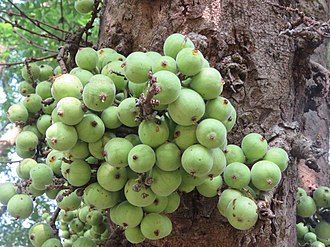
Ficus racemosa
-cluster fig
- Ficus racemosa, the cluster fig, red river fig or gular,is a species of plant in the family Moraceae. It is native to Australia and tropical Asia.
- It is a fast-growing plant with large, very rough leaves, usually attaining the size of a large shrub, although older specimens can grow quite large and gnarled.
- It is unusual in that its figs grow on or close to the tree trunk, termed cauliflory.
- The fruits are commonly eaten as a vegetable after the seeds have been discarded, and made into stir-fries and curries.
- The fruits are a favourite staple of the common Indian macaque. It serves as a food plant for the caterpillars of the two-brand crow butterfly (Euploea sylvester) of northern Australia.
USES:-
- Ficus racemosa is a medicinal plant in India used for various diseases, and studied for antidiabetic, antipyretic, anti-inflammatory, and other activities.
- Leaves are used in various ways for medicinal purposes. Leaf powder mixed with honey is used for bilious infections, while a decoction of leaves is used as a douche for dysmenorrhea and as a wash for wounds and ulcers. Leaf juice is applied to hair to prevent splitting, while leaf latex is used for boils, blisters, and measles.
- The fruit is used as an astringent, stomachic, and carminative for menorrhea and hemoptysis. It is also used to treat visceral obstruction, diarrhea, and constipation. The fruit and bark bath is believed to cure leprosy, and the fruit is considered a good remedy for diabetes.
- The bark has multiple medicinal uses. It is an astringent and is used as a mouth wash for various conditions. It is recommended for threatened abortions and uropathy, and the decoction is given for asthma and piles. The sap extracted from the trunk is used for diabetes, and the paste of stem bark is used for burns, swelling, and various types of infections.
- The latex has various medicinal uses, including treating diarrhea, dysentery, hemorrhoids, and stomachache. It is also used for aphrodisiac purposes and to treat cholera and mumps. In Sri Lanka, it is used for treating skeletal fractures and severe diarrhea in children. Moreover, the latex is used as an adhesive.
- The root sap is used to treat gonorrhea, diabetes, and inflammatory glandular enlargements. It is also used to cure heat stroke, chronic wounds, and malaria in cattle.
Cultural & Historical Importance:
- According to the Shatapatha Brahmana, the Audumbara tree was created from the force of Indra, the leader of the gods that came out of his flesh when he overindulged in soma
- From his hair his thought flowed, and became millet; from his skin his honour flowed, and became the aśvattha tree (ficus religiosa); from his flesh his force flowed, and became the udumbara tree (ficus glomerata); from his bones his sweet drink flowed, and became the nyagrodha tree (ficus indica); from his marrow his drink, the Soma juice, flowed, and became rice: in this way his energies, or vital powers, went from him.
- In the Atharva Veda, this fig tree (Sanskrit: Umbara or Audumbara) is given prominence as a means for acquiring prosperity and vanquishing foes. For instance, regarding an amulet of the Audumbara tree,
- The udumbara is a plant and flower referred to as Audumbara in Buddhism. It's also known as the blue lotus and appears in the Lotus Sutra. The Japanese word udon-ge refers to the udumbara flower and is used by Dōgen Zenji in Shōbōgenzō. The udonge is also used to refer to the eggs of the lacewing insect and is used for divination in Asian fortune telling.
Plantation:-
- Soil
Ficus grow best in soils with a pH between 6.0 and 6.5, avoiding soils labeled for azalea or rose use.
- Climate
The tree prefers humid climates and thrives in moist soils.
- Location
It is often found growing near rivers and streams.
